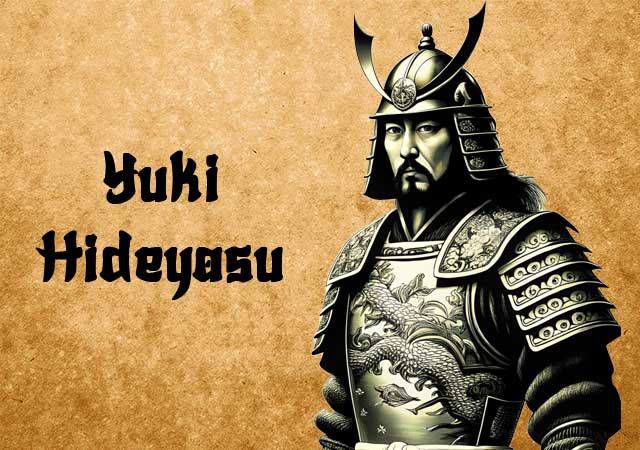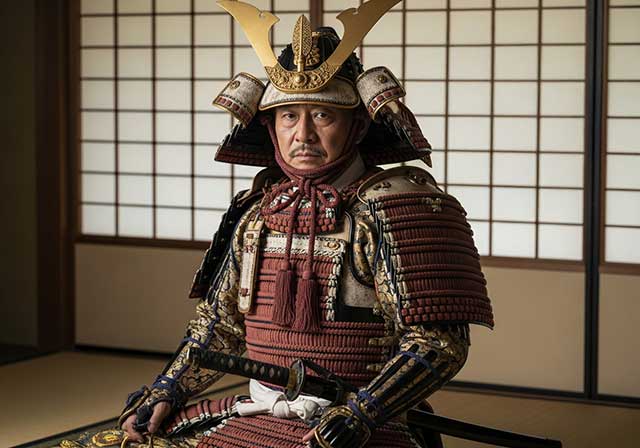
Yuki Hideyasu (March 1, 1574 – June 2, 1607) was a Japanese samurai who lived during the Azuchi–Momoyama and early Edo periods, serving as the daimyō of Fukui Domain in Echizen Province. Born Tokugawa Ogimaru, he was the second son of Tokugawa Ieyasu and Lady Oman (also known as Lady Kogō), a handmaiden to Ieyasu’s wife, Lady Tsukiyama. Due to Ieyasu’s fears of his wife’s reaction to Oman’s pregnancy, Ogimaru and his twin brother were born in secrecy at the home of Honda Shigetsugu, one of Ieyasu’s retainers. Oman’s other son eventually became a priest, while Ogimaru was raised apart from Ieyasu, whom he only met at the age of three, in a meeting arranged by his older half-brother, Matsudaira Nobuyasu.
After Nobuyasu’s forced seppuku at Oda Nobunaga’s command, Ogimaru became next in line to inherit the Tokugawa clan. However, as part of peace negotiations following the Battle of Komaki-Nagakute in 1584, he was given in adoption (effectively as a hostage) to Hashiba Hideyoshi. While under Hideyoshi’s care, Ogimaru came of age and was renamed Hashiba Hideyasu, a name that honored both his adoptive and biological fathers. He also received the title of Mikawa-no-kami and the Court rank of Senior Fifth Rank, Lower Grade, which was later elevated.
Hideyasu’s military career began with distinction, as he led the assault on Buzen-Iwaishi Castle during the Kyushu Campaign of 1587 and contributed to the pacification of Hyuga Province. He also participated in the Siege of Odawara in 1590 and the Japanese invasions of Korea (1592–1598), earning a reputation as a skilled and promising commander. However, in 1589, the birth of Toyotomi Hideyoshi’s natural son, Toyotomi Hideyori, altered Hideyasu’s trajectory. To avoid succession conflicts, Hideyasu was adopted by Yuki Harutomo of Shimōsa Province in 1590, marrying Harutomo’s niece and becoming the head of the Yuki clan, with a domain of 101,000 koku.
Despite his military achievements, Hideyasu’s loyalty to the Toyotomi clan raised concerns. During the Battle of Sekigahara in 1600, Tokugawa Ieyasu ordered Hideyasu to remain in Shimōsa, possibly due to doubts about his allegiance or to avoid overshadowing Ieyasu’s chosen successor, Tokugawa Hidetada. Following the Tokugawa victory, Hideyasu was rewarded with Echizen Province, a vast domain of 670,000 koku. In 1604, he was permitted to adopt the Matsudaira surname, and by 1605, his court rank was elevated to Senior Third Rank, along with the courtesy title Gon-Chunagon.
Hideyasu passed away in 1607 at the age of 34, possibly due to complications from syphilis. His death occurred shortly before the Siege of Osaka, where the Toyotomi clan was ultimately destroyed. In his will, Hideyasu urged his son and heir, Matsudaira Tadanao, to support Toyotomi Hideyori if the Tokugawa attacked. However, Tadanao ignored his father’s wishes, ensuring the survival of the Echizen-Matsudaira clan, which endured until the Meiji Restoration in 1868.
See also
-
Sakakibara Yasumasa

Yasumasa was the second son of Sakakibara Nagamasa and was born in Ueno in Mikawa Province. From a young age, he began serving Tokugawa Ieyasu and eventually rose to the position of one of his most trusted generals. His wife was the daughter of Osuga Yasutaka. Ieyasu first noticed the young Yasumasa during the suppression of the Ikkō-ikki uprising in Mikawa in 1564. Thanks to his demonstrated abilities, Yasumasa was granted the privilege of using the character “yasu”—the second character of Ieyasu’s own name—in his own. Although he was the second child in his family, he became his father’s heir, though the exact reasons for this remain unknown.
-
Sakai Tadatsugu

Tadatsugu was one of the most renowned generals serving Tokugawa Ieyasu. After Ieyasu broke ties with the Imagawa clan, Tadatsugu—an ardent supporter of this decision—was granted command of Yoshida Castle in 1565, which controlled the coastal road from Tōtomi to Mikawa. During the Battle of Mikatagahara in 1573, he held the right flank of the Tokugawa forces even when the troops sent by Oda fled under the assault of the Takeda army. In the Battle of Nagashino in 1575, he personally requested permission to carry out a night attack on the Takeda camp, which he executed brilliantly together with Kanamori Nagachika.
-
Ryuzoji Takanobu

Takanobu was the eldest son of Ryūzōji Takaie and the great-grandson of Ryūzōji Iekane. His father was killed by a man named Baba Yoritiku in 1544. At a young age, Takanobu took Buddhist vows and received the monastic name Engetsu. However, around the age of eighteen, he returned to secular life, and in 1548, after the death of Ryūzōji Tanehide, he became the head of both branches of the Ryūzōji family.
-
Ouchi Yoshihiro

Ōuchi Yoshihiro was the second son of Ōuchi Hiroyo, who headed the Ōuchi clan in the western part of Honshu. In 1363, Shogun Ashikaga Yoshimitsu confirmed the Ōuchi family in the position of shugo of Suō and Nagato Provinces. In his youth, Yoshihiro assisted his father in strengthening the influence of the Northern Court on the island of Kyushu — they served under Imagawa Ryōsun, who had been tasked with subjugating the nine provinces of Kyushu.
-
Ouchi Yoshioki

Ouchi Yoshioki, the ruler of the provinces of Suo, Nagato, and Iwami, was one of the most capable military commanders and politicians of the late 15th and early 16th centuries. The son of Ouchi Masahiro, he governed from his residence in Yamaguchi in the province of Suo. In 1499, Yoshioki gave refuge to Shogun Ashikaga Yoshitane, who had been driven out of Kyoto by Hosokawa Masamoto. Shogun Yoshizumi, Masamoto’s protégé, ordered the lords of Kyushu to unite their forces against Yoshioki; however, they did not dare to do so, fearing the power of a man who by that time controlled six provinces. Having gathered a substantial army, Yoshioki marched from his native Suo toward Kyoto in order to restore Shogun Yoshitane to power.
-
Otomo Sorin

Ōtomo Yoshishige came from a noble lineage, being the eldest son of Ōtomo Yoshiaki, the ruler of Funai Province. The roots of the Ōtomo family traced back to Fujiwara Hidesato, the adopted son of Nakahara Chikayoshi. Fujiwara served Minamoto Yoritomo during the Genpei War and took part in battles in Mutsu Province in 1189. In 1193, he was appointed shugo of Buzen and Bungo Provinces, after which he adopted a new surname—Ōtomo.
-
Okudaira Sadamasa

Sadamasa was the son of Okudaira Sadayoshi and took part in several battles under Tokugawa Ieyasu, distinguishing himself in the Battle of Anegawa in 1570, where he took two heads. Around 1572 he was forced to enter the service of the Takeda clan, but after the death of Takeda Shingen in 1573 he returned to Tokugawa, leaving Tsukude Castle together with his men. As a result of this defection, Takeda Katsuyori ordered the execution of Sadamasa’s wife and brother, who were being held as hostages.
-
Okubo Tadatika

Tadatika, the son of Okubo Tadayō, entered the service of Tokugawa Ieyasu at the age of eleven, and took his first head in battle when he was sixteen. After the establishment of the Tokugawa shogunate, he was appointed as a rōjū — a senior bakufu official — and was regarded as one of Ieyasu’s most trusted advisors, alongside Honda Masanobu. He is also known for his military chronicle Mikawa Monogatari, which describes Ieyasu’s rise to power and the early years of the Tokugawa shogunate.

